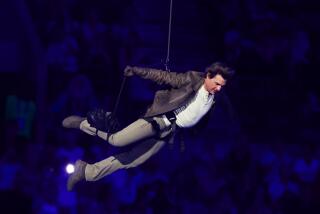No Lions, Tigers or Bears? Cirque Soars With Just People
- Share via
This is about Cirque du Soleil. Translation from French: Circus of the Sun.
That’s the dazzling, kaleidoscopic Canadian troupe making a spectacular debut Sunday night as a pay-for-view television attraction from TVN Entertainment. Animal-free circus as theater, even on a small screen it makes the conventional, sawdust-as-usual Circus Vargas and Ringling Bros. and Barnum & Bailey crowds look like “The Gong Show.”
But first this prologue:
There’s a famous song in “Fiddler on the Roof” that celebrates tradition.
It came to mind during a recent PBS documentary about the family-run Tarzan Zerbini Circus that began in Italy in 1763, and still tours in Europe and North America, proudly honoring its roots in an arc of continuity spanning generations.
Very inspiring.
The hour ended with Tarzan’s daughter, Patricia, speaking about making her mark as an elephant trainer, as her father did in the big cage showing mastery of tigers. And there she was strutting under the lights, all glittery and phosphorescent in her costume, performing before an appreciative audience with her “trainees,” five elephants.
An elephant swung her around as she hung from one of its tusks. Two elephants somehow balanced their massive bodies on small platforms while lifting her with their trunks. Two let her plant a leg on each of their heads and do a split. Later, all five rolled over and played dead. Then they sat on their rumps with their front legs thrust forward. Finally, they paraded in a circle to music before leaving from the ring on their hind legs, the last one stopping to wiggle the tip of its trunk as if saying goodbye.
Very sad.
It recalled a recent quote in The Times from Phil McKinley, director of the Ringling Bros. and Barnum & Bailey Circus--the world’s largest--now at the Anaheim Pond. Describing the show’s signature “Living Carousel” number, a lineup of trainers and animals that includes at least a dozen bedecked elephants up on their hind legs, he said:
“I wanted to create a moment in the show where you saw humans and animals living in harmony together.”
This is harmony?
Another view: The only way to achieve it with animals is for humans to stop exploiting them. That includes not gussying them up and forcing them into unnatural behavior as circus performers that are granted about as much respect as cotton candy. There are periodic reports of trainers physically abusing their animals, some of these charges having been confirmed, others not. One could argue, though, that contorting animals to fit circus entertainment values, however the means, is an act of cruelty.
This is one tradition that cries out for term limits.
Although some circuses with animals still pack them in, there are more humane ways to operate, to say nothing of more creative, exciting and exotic, as fans of 15-year-old Cirque du Soleil and the growing number of other animal-free circuses have discovered.
For the uninitiated, proof arrives Sunday in 90 tailored-to-TV minutes of a long-touring Cirque du Soleil production titled “Quidam,” following a half-hour pre-show with background and interviews. Fifteen cameras, from ceiling to floor, capture the beauty, choreography, athleticism and originality. How far TV has come since those early days of Ed Sullivan’s plate-spinners.
Director David Mallet has a lengthy pedigree when it comes to mounting high-profile TV events. Yet unlike the recent overcooked, untelegenic “Lord of the Dance” and “Feet of Flame” specials he directed for fast-tapping, high-stepping Michael Flatley, “Quidam” fits right into the TV groove by balancing size with intimacy.
Staged before an audience in Amsterdam, this Cirque is entertainment perfection, its astonishingly gifted cast of street-style performers, jugglers, balletic gymnasts and high flyers creating a hybrid of exquisite whimsy and magnificent oddity. There are clowns, too, each of their faces a work of art, for in addition to the haunting music and performances, this is as much a triumph of Nathalie Gagne’s makeup, along with Dominique Lemieux’s costumes, Luc Lafortune’s lighting design and, of course, Franco Dragone’s artistic direction and Mallet’s TV guidance.
Siegfried & Roy, eat your hearts out.
“Quidam” is said to be Latin for “the anonymous passer-by,” and although its plot or message can be detected only with a Geiger counter, Dragone insists the show “highlights our frailties and our anguish in the face of the new millennium.”
Well . . . if he says so. Another reading, however, is that it’s just plain wonderful to watch, in most ways not matching the ambience of Cirque du Soleil in the flesh, yet in some ways better. Get a gander, for example, of the emotion on Isabelle Chasse’s face, caught in close-up as she entwines herself in a column of red silk high above the ground in the show’s most stunning sequence. You wouldn’t see that in person.
Look, may the Flying Whomevers prosper and not split their tights or fall once under the old-style big top. May those fright-wigged, bulb-nosed, flap-shoed clowns continue climbing from that tiny Volkswagen indefinitely. Some tradition is nice. Yet so is the alternative.
Created in Montreal 15 years ago, Cirque du Soleil is the product of shrewd marketing and extraordinary talent recruited from international circus schools and even the Olympics. Now a global phenomenon with several permanent shows and a spate that tour, it projects attendance of 5 million this year. No wonder, for as first-time viewers who take the plunge Sunday will learn, it’s truly great stuff.
And not one elephant.
* “Cirque du Soleil: Quidam” pay-per-view airs Sunday at 5 p.m. with a second showing at 6:30 p.m., available via cable and satellite for $19.95.
More to Read
The biggest entertainment stories
Get our big stories about Hollywood, film, television, music, arts, culture and more right in your inbox as soon as they publish.
You may occasionally receive promotional content from the Los Angeles Times.










